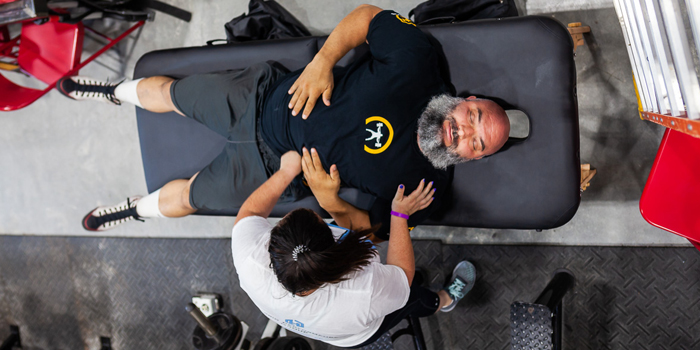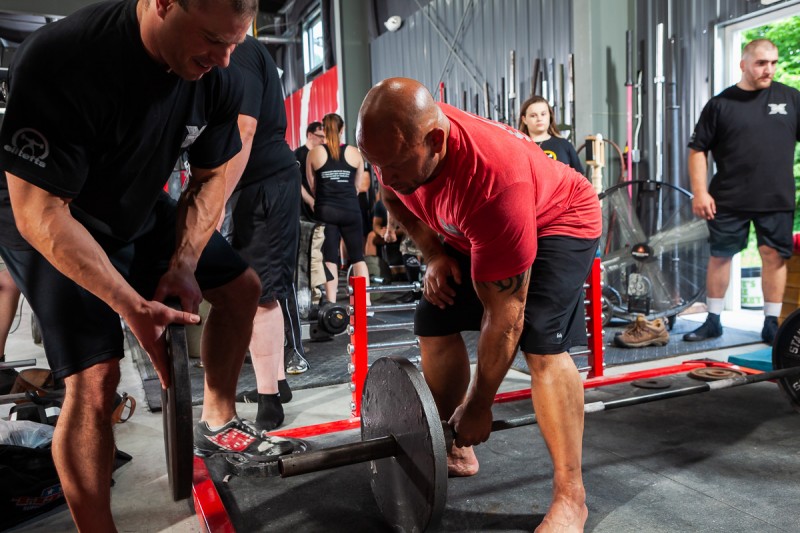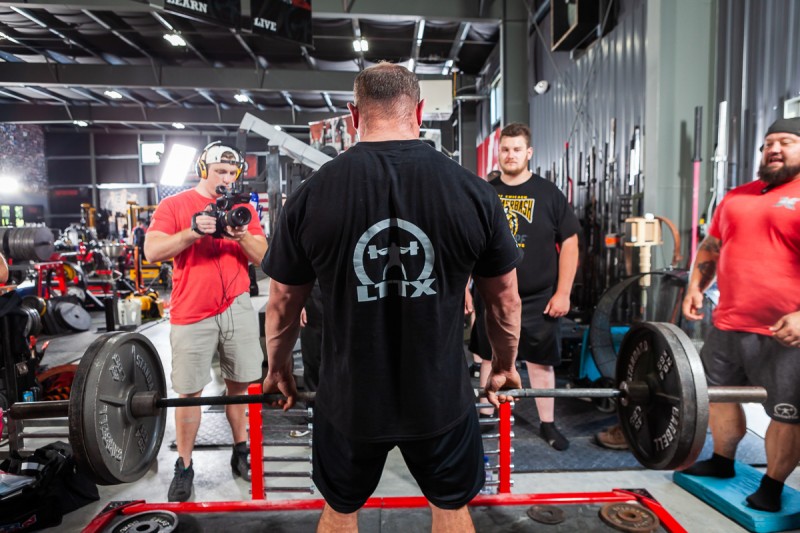
An injury is often very difficult to understand for the athlete who has just been injured. They can often seem to come out of nowhere, for no apparent reason, but make no mistake about it, very few injuries occur in isolation. Oftentimes there are a trail of signs that, if recognized properly, can lead to proper navigation and prevention of an injury – as is the goal of this series. Being better equipped to spot and understand the warning signs of a future injury can be your lifesaver.
Injuries can prove to be difficult. They can be hard to pinpoint, hard to describe to another person, and can certainly be hard to manage on your own. Sometimes rubbing the area in question with a piece of gym equipment seems to help. Other times switching one movement out for another does the trick. If an injury seems to be confusing it can be because you are either trying to solve a puzzle without enough pieces or you are trying to oversimplify an injury before understanding its complexities.
RECENT: Troubleshooting Strength Injuries: Defining Injury
To some of you, this may sound like a lot of run-around. For others, you may be nodding your head in agreement. This is because each reader is going to be at a different experience level and competence with training and dealing with injury. This is normal, and it is the same path to growth and mastery that every person in every walk of life travels. I’m not trying to educate you to be a doctor, but I am going to give you as much information as I can to move you to the next level of competence in understanding the warning signs of your own body.
Becoming Competent
Learning to master any movement, concept, or skill requires the individual to progress through four levels of competencies. Unconscious incompetence, conscious incompetence, conscious competence, and finally, unconscious competence. At any given point in time, you will fall somewhere on one of these ranges in everything you do.
When you were born, you were the ultimate example of unconscious incompetence. You completely relied on everyone for everything, and if left alone in the wrong situation, you could shit yourself, puke all over yourself and drown in your own puke in a matter of minutes. As you aged, you began this process of moving through the various levels of competence.
tiagozr © 123rf.com
At some point, your parents decided that they did not want to spend another year changing your diaper and made you aware of this being a problem. You realized that indeed this was a problem but didn’t quite have the will or knowledge of how to control not shitting yourself every day. At that point, you moved into conscious incompetence. You realized (whether you liked it or not) the lack of competence and began the journey to learn how to solve it.
Eventually, you became able to use the toilet at a reasonable rate during the day. Yes, there were still times when you struggled and had an accident, but for the most part, you did pretty well. Congrats! You get a gold star! And since it’s 2019, you’d probably also get your own party, a new toy, and taken out for both pizza AND ice cream just to show you how special you really are!
You were also at the point where you didn’t have to wear a diaper and instead received your own fresh pair of big boy or girl underwear! That was just during the day; however, as you were still wetting the bed at night. You became (consciously) competent when you spent time and effort focusing on it, but when you were sleeping or really distracted, you were still unable to hold your bladder back and warn yourself that you needed to use the bathroom.
After spending significant time in the conscious competence stage, at some point, you finally learned how to listen to your body and see the signs that now all warn you to find a bathroom before you had an accident.
WATCH: I am Dr. Tyrel Detweiler
Now, when you see those signs coming, you place priority on adapting whatever you are doing at that moment to make sure your body is able to relieve itself appropriately. Conscious competence ensures that you avoid a situation turning into a complete mess that you have to spend time and energy cleaning up – literally.
The athlete involved in the example injury from the last article either was unaware of the warning signs that he should be concerned about, failed to recognize them, or chose to disregard them. This injury does not have to be yours! Understanding the warning signs and red flags of injury are paramount to successfully pushing your body to the brink without derailing due to injury.
So what signs did our example athlete miss? Rather than list them all out like answers on a test for the sake of getting a question right, let’s look at the various categories from which we can pull information to recognize warning signs to be aware of.

Stress
First and foremost, the one concept that you need to get through your head right now is that every stress is perceived in the exact same way by your body. And when I say, “body,” I am literally talking about the entire body. Your entire body responds to a fight with your significant other, your repetitive sitting at work, lack of sleep, and the weight you place on your back in the exact same way. This is often passed by and understood simply as the musculoskeletal system, but make no mistake about it – every system in the body responds at some level to stress, which can affect your performance. This is primarily because any input to your body that is a stress to your body will be perceived as such by the nervous system. Since the nervous system is in control of every other system, it can lead to all sorts of adaptations across all systems. Blood pressure, heart rate, mood, ability to sleep, fighting off a cold, trigger points in your shoulders and upper back… all of these are possible through stress and the response to stress by the nervous system.
Now, clearly, the magnitude of that stress varies. A max effort movement will place a larger magnitude of stress on the body and will cause more direct damage to a hamstring than sitting at a computer desk. But you must also take into account the frequency of the stressor as well. Sitting at work for more than 40 hours a week and spending another hour per day in a car commuting to and from work and the gym is a drastically higher frequency than the three to nine reps you spend over 90 percent of your max. Both matter, and in all honesty, it takes a much higher level of understanding to see the effects of stress that comes from a fight with your spouse than it does to see it from a heavy deadlift.
In the next session, we will cover different types of stress. These are less “types” of stress and more categories of places or situations in your life from which people typically derive stress. You could also re-categorize these stressors as physical, mental, environmental, and life stressors.
RELATED: Hybrid Performance Group — A One-Stop Shop for Recovery
Work Place Stressors
Since most adults spend most of their time at work, and because work plays such a large part in the quality of life we are able to live, this is a very common place for stress.
Stressors here include the physical and mental demands of the job, as well as the relationships that you have with the company you work for, the business you own, or the employees/co-workers you engage with.
In the example from the first part of the series, the lifter worked a blue-collar job that required him to stand and work 50 hours a week with his hands. Perhaps this was on a construction site, an assembly line, or as a mechanic, which would require heavy boots and possibly standing on hard or uneven surfaces. All of these scenarios can absolutely wear away at the legs, lower back, and trunk.
Training Stressors
These are stressors that are derived from the demands of your current training program, or the mental stress, perceptions, and focus associated with training. This is more of the traditional stress loads that many are used to: Volume, workload, etc. It also includes the things you do or don’t do in your training to prepare you to lift and also how you approach each movement with focus and intent and follow the program.
Our example lifter has technique issues with his deadlift and has changed his training program five or so weeks out from a meet by adding in three extra movements and not taking anything out. He further strays from his training program and hits a 1-rep max with broken form rather than a heavy three. He also decides to ignore the pain in his deadlift session and during the squat session when he hurt himself.
Environmental Stressors
Environmental stressors can be anything within one’s environment that has direct physical stress on them. This can be medications, quality of food, pollutants in the air, in our homes, etc. These stressors are not present in our example lifter’s environment.
Life Stressors
Life stressors include anything else that is just a general part of life. This could be sleep quality, quantity, family, friends, sitting posture, sleeping posture, or anything else that has to do with general life activities and interactions. In this example, we see that the individual has a chronic lack of sleep.

Recovery
The ability to recover is also a huge factor that should be understood and will alarm you of the possibility of future injury. Recovery is the process from which your body adapts to the stresses you place on it. It is the adaptation response of recovery that actually improves your performance.
A lack of recovery or sub-par recovery means a less resilient athlete is more prone to injury. If training loads are too high and recovery is not there, the body will be unable to return back to full capacity from one training session to another. Sometimes this can be accounted for when increasing recovery or training the resilience of that athlete to training stress.
The inability for the body to recover can be perceived in multiple ways. Pain and discomfort are the most common signs. Changes in heart rate, blood pressure, appetite, ability to sleep, general mood, and lack of motivation can also be very good signs of a lack of recovery. Many athletes may describe subjective information such as feeling “off,” “down,” “tired,” or “gassed,” which can be signs of neural fatigue and lack of recovery.
There are many warning signs that we can see in this example. As mentioned before, the athlete is not sleeping enough and has also added in more movements recently. Both will drastically affect recovery. The athlete also sensed subjective signs other than pain when warming up. He felt tight and was unable to get the explosiveness or essentially the “feel” that he normally does when squatting.
This strength athlete is clearly in the unconscious incompetence phase or too stubborn to listen to what was going on and adjust his training, which could have headed off his injury. The reality is that a majority of lifters find themselves in either of those two categories when it comes to understanding their body. They either don’t know what they don’t know, or they fail to listen, thinking they can just push through.
Building a better knowledgebase of the stresses being placed on the body, the recovery necessary to adapt to those stresses, and how to understand the current state that your body is in should be your biggest priorities as an athlete.
Now, you may say, “That’s why I hire a coach,” or “That’s why I go see my healthcare provider.” But the truth is, no matter how good a practitioner or coach is at what they do, they do not know as much about your body and what you feel as YOU do. If they have spent enough time working with you, they do likely know the objective signs to look for from you and their programming or therapy that allow them to PREDICT how you feel, but YOU, and only YOU, can articulate how YOU feel.
But being able to understand your body, training, the ability to recover, and how those factors all inter-relate opens up a hugely important ability to your success as an athlete. This ability, which will be covered in the next installment, is auto-regulation.











